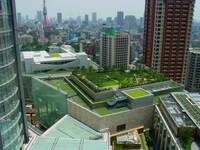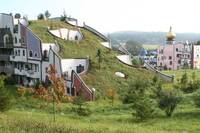- England
- Scotland
- France
- Holland
- Germany
- Italy
- Spain
- Portugal
- USA
- China
- Japan
- India
- Iran
- Advice
- Gardens
- England
- Scotland
- France
- Holland
- Germany
- Italy
- Spain
- Portugal
- USA
- China
- Japan
- India
- Iran
- Advice
- Garden Tours
Book: Landscape Planning and Environmental Impact Design: from EIA to EID
Chapter: Chapter 9 River engineering, channelization and floods
Vegetated roofs help prevent flooding.
Because they are smooth and steeply inclined, un-vegetated roofs tend to have the fastest rainwater discharge rates of any surfaces in urban areas. Vegetated roofs [Fig 9.17] discharge less water and the rate of discharge is reduced: Roof water is transpired by plants and used in metabolic processes. Roof water is retained as soil moisture. Flat roofs have additional detention capacity. Roof water is returned to the atmosphere by evaporation. Roof surfaces have higher evaporation rates than ground surfaces, because they are more exposed to sun and wind. Vegetation increases the area from which evaporation can take place. Cumulatively, these effects are significant. From a light shower, there will be no runoff. From a moderate shower, only half the precipitation may be discharged from the roof. With a heavy shower, there may be an hour or more delay before there is any discharge from a previously dry roof. The total annual discharge may be halved.


